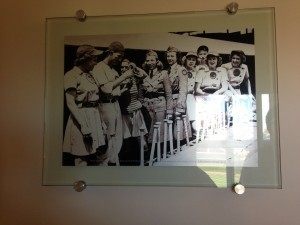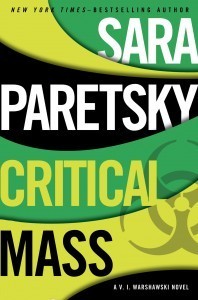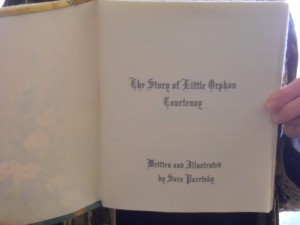Sara Paretsky's Blog, page 11
June 3, 2013
Buy Me Some Peanuts…
Everyone knows that V I Warshawski is a Cubs fan, but it’s been a while since she went to the ballpark. For a book I’ve just started writing, I’m imagining a chase scene, down those nasty old corridors between the visitors locker room and the dugout, so I persuaded some friends to come with me for a tour of the park today.

Sara with Jo, Kathy and Louis
The weather couldn’t have been more perfect, 65 under cerulean skies, and we had a lively and knowledgable guide, who gave us some fun facts about the field, and baseball history. Charles Weeghman, who built the park, was a restauranteur–he installed the first concession stand in major league ball. The Wrigleys took over the majority ownership in 1920 and expanded the field, which was originally only about 2/3 its current size.
As most baseball people know, the Wrigleys thought night games would be a passing fad, although they did have a plan to install lights in 1941. After Pearl Harbor, they shipped the lights up to the Great Lakes Naval Training Station for use in simulating night landings on aircraft carriers, and it was another 47 years before permanent lights were installed. However, the All-American Girls Professional League played their 1943 championship game at Wrigley under temporary lights.

AAGPL Photo at Wrigley Field
We weren’t allowed into the dugouts because high school prospects were trying out on the field, but we got to see the locker rooms–very bare-bone affairs compared to some of the newer parks, but surprisingly enough, all of the parks have pretty utilitarian facilities–just a place to hang clothes, a little safe for valuables, a chair to sit in before the game. Interesting factoid about laundry: the home team is responsible for washing the visitors uniforms. The night before a team arrives, a courier deposits their dirty laundry at the home park, where the staff launders the clothes and has them hanging up in the visitors’ locker room by the time the team arrives. Jobs I’m glad I don’t have…

View of the Field From the Press box

View of the City from the top of Wrigley Field

In the visitors locker room
We did get to sit in the press box, and, since no one was around, use the men’s room outside, which has an amazing view of the city.
I’m not sure I can really set a chase scene here–the fun place would be the old scoreboard, which no one is allowed into–but I do have my heart set on another possibility: guest host of the 7th Inning Stretch.
April 28, 2013
Critical Mass
Here’s the synopsis of VI’s next adventure
Vienna in the 1930’s was both an exciting and a terrifying place to be a woman doing physics. Exciting because the Institute for Radium Research offered women opportunities that no lab before or since has provided. Terrifying because although the Nazi party was outlawed, pro-Nazi sentiment ran high. For a woman who was also a Jew, political events could spell the end not just of her career, but her life.

Sara Paretsky at the entryway to the IRF, Vienna
Critical Mass tells the story of one such woman scientist, Martina Saginor, a (fictitious) physicist who disappeared in the slave labor camps of World War II. Thanks to the Kindertransport, Martina’s only child, Kitty, made it to safety in England in 1939; after the war she resettled in Chicago.
Kitty’s story is closely twined with that of another Viennese refugee, Dr. Lotty Herschel, the friend and confidante of Chicago private eye VI Warshawski. When Martina’s tortured history starts coming to light in contemporary Chicago, Lotty turns to V I for help. In Critical Mass, the secrets of the bomb, of the Second World War, and of the human heart take VI on a quest from Chicago’s premier science labs to the Viennese ghetto where Lotty and Martina were forced to live. The journey across present and past makes V I a moving target for powerful figures who’d like to see the past stay dead and buried.

Critical Mass will be published by Putnam’s on October 22.
April 2, 2013
March 25, 2013
Passover
It’s bleak in Chicago, hard to believe that Passover starts at sundown tonight. It’s a holiday like Easter that should serve as spring’s harbinger. When I was a child, it was my job to wash all the special Passover dishes. My brother Jonathan would help me. We’d drive into town to buy the special foods for the ritual dinner. I would coach him on reciting the Four Questions, which the youngest child must ask. When he was four and my dad insisted he learn them in Hebrew, I drew a picture of his brain and showed him the part of his brain where the strange-sounding words would lodge themselves. Somehow this made it possible for him to become word-perfect.
Now, living with someone who despises rituals, I don’t bother to make a seder: like all Jewish holidays, Passover is a communal, not a solitary ritual. I go on the second night to a friend’s house, where we use a Haggadah another friend and I constructed over the course of a decade, our Women’s Haggadah, which frames questions and ritual through a woman’s lens. I love this ritual, but I miss the excitement and pageantry of a first-night celebration.

Seder Plate with Orange
I shopped today for the Seder plate, which includes greens and a boiled egg to celebrate spring, bitter herbs to remind us of the bitterness of slavery, chopped apples and nuts to symbolize the mortar the Hebrew slaves were denied when Pharaoh demanded they build his pyramids; salt water to remind us of the tears of the oppressed; a lamb bone to remind us of the Holy One’s mercy in saving the first-born of the children of Israel; and an orange, to symbolize women’s freedom to lead religious services.
I am grateful that I live in a country where I can freely ask a butcher for a lamb shank for my seder plate. I am grateful that I do not need to hide my religion.
For everyone, Passover is a holiday that celebrates the movement from slavery to freedom. It demands that we ask what we are enslaved to. If we are free people, what habits or fears or addictions, be they computer games or texting or drinking or other obsessions, keep us from experiencing life in a full and free way? I have my own obsessions and addictions, but what troubles me more is my enslavement to a bleakness of spirit. I hope that this year marks my going forth from that bleak land to one of greater richness of spirit. I hope that wherever you are on your own road from bondage to a land flowing with milk and honey, you will find something in this holiday to quicken your spirit and give you strength for the journey.
March 14, 2013
Critical Mass On Sale October 22
V.I. Warshawski’s newest adventure uncovers secrets buried in the rubble of World War II. A particle physicist, V.I.’s beloved friend Lotty Herschel, and meth labs of rural Illinois all come together to form a Critical Mass of crime, intrigue, and passion. Published by G.P. Putnam’s. On sale everywhere on October 22nd. Pre-order here. Booklist’s starred review says:
“As in previous V.I. mysteries, Paretsky works elements of Chicago history into the story, this time referencing the city as a nexus for atomic research and linking the science of the work conducted in Austria during the Nazi occupation… Vic is at her stubborn, reckless, compassionate best in this complicated page-turner about selfish secrets passed down through generations…Paretsky has been on a roll lately, her long-running, trailblazing series at its most dynamic since the early days.”
Critical Mass On Sale October 23
V.I. Warshawski’s newest adventure uncovers secrets buried in the rubble of World War II. A particle physicist, V.I.’s beloved friend Lotty Herschel, and meth labs of rural Illinois all come together to form a Critical Mass of crime, intrigue, and passion. Published by G.P. Putnam’s. On sale everywhere on October 23rd. Pre-order information will be posted as soon as it’s available.
February 28, 2013
New UK Editions
Hodder & Stoughton have released new editions of Sara’s backlist. You can see the beautiful new covers and order your own copies at their website.
January 29, 2013
Returning Veterans and Crime Fiction
I just started reading a new novel whose protagonist is a returning Iraq-Afghan veteran. Like most fictional vets, he suffers flashbacks and nightsweats; as the reader, I don’t yet know if he will also suffer PTSD and go off the rails, although it’s a good bet.
I do know that the returning vet has become a stock figure in contemporary crime fiction, and I wonder why. Although I have several friends and many relatives who are vets, I don’t personally know any crime writers who are Iraq-Afghanistan war veterans. Robert Parker served in the Korean war, and early on, Spenser mentions serving in that war. Tony Hillerman was decorated in World War II. A number of Vietnam vets have written thrillers as well as general fiction (Dan Guenther, Dale Dye, Stephen Coonts and Nelson DeMille, among others). Vietnam, Korea, World War II–not wars you wanted to see close up and personal, any more than are Iraq and Afghanistan, but many Americans did see those wars because of a pesky little thing called The Draft.
Crime writers today are like the rest of the country: we didn’t have to go to war, so we didn’t go. Less than one percent of Americans have served in the military during the Iraq-Afghan wars. Ten times that fraction served in World War II and Korea; five times that fraction served in Vietnam. All of us are therefore more likely to know a veteran from a draft-era war than we are now.
So why is it that protagonists in contemporary crime fiction far outnumber the fraction of the population in general who went to war? Is it a way of assuaging guilt? Or a vicarious machismo? Or because veterans are now exotic? Is this a different version of a yellow ribbon? We put one on our cars and then we don’t have to think about what is really going on in the lives of our children 8000 miles away? We write about a vet so we don’t have to think about the sacrifices real people are making in our collective name?
There are no sacred cows for writers; you can write about anything and anyone. But the returning vet is a a two-dimensional cliché in most of the contemporary thrillers I see: he/she is inured to death, is a killing machine, is an emotional time bomb.
It’s hard for the vet, it’s hard for the families to resume life after years of separation. The father of my best friend in high school was a naval commander. He was at sea for long periods and my friend’s mom ran the house, made repairs, paid the bills. When Commander MacKenzie came home he expected to be in command, to take over the conventional male duties of the Madmen era. My friend, her sister and her mom always had many weeks of discomfort on the commander’s return; it was hard on the marriage to have him gone and hard to have him home. I’d like to see those issues written about real people, not cardboard cutouts.
If all you need is a character who’s a soulless killing machine, don’t look at vets: we’ve got a huge collection of civilians to choose from.
Returning Veterans and Fiction
I just started reading a new novel whose protagonist is a returning veteran. He suffers flashbacks and nightsweats; as the reader, I don’t yet know if he will also suffer PTSD and go off the rails. I do know that the returning vet has become commonplace in contemporary crime fiction, and I wonder why. Although I have several friends and many relatives who are vets, I don’t personally know any crime writers who are Iraq-Afghanistan war veterans. Robert Parker served in the Korean war, and early on, Spenser mentions serving in that war. Tony Hillerman was decorated in World War II. A number of Vietnam vets have written thrillers as well as general fiction (Dan Guenther, Dale Dye, Stephen Coonts and Nelson DeMille, among others). Vietnam, Korea, World War II–not wars you wanted to see close up and personal, any more than are Iraq and Afghanistan, but many Americans did see those wars because of a pesky little thing called The Draft.
But crime writers today are like the rest of the country: we didn’t have to go to war, so we didn’t go. So why is it that protagonists in contemporary crime fiction far outnumber the fraction of the population in general who went to war? Is it a way of assuaging guilt? Or a vicarious machismo? Or–? I think you can write about anyone doing anything, as long as you do it with thought and empathy, but I’m not sure the stock figure of an emotionally damaged vet makes us think more deeply about Iraq-Afghanistan or what we were doing as a country when we so blithely invaded Iraq 10 years ago.
December 27, 2012
Best Books of 2012
I recently asked some knowledgeable book people for the best books they’d read in 2012 (whether they were published this year or not.) Since I’m a reader as well as a writer, I’m always looking for something interesting to read. I loved the suggestions–I’d only heard of about a third of the titles, so my 2013 reading list is already underway. Dig in, see what you love, what you don’t know, what you maybe didn’t like as well as these people did, and feel free to add your own comments to the list below.

The Story of Little Orphan Courtenay, Written and Illustrated by Sara Paretsky
Ayo Onatade & Kelly Hager - Attica Locke’s The Cutting Season
Sara Jayne Townsend, Linda Gustavson, Izzanie Ismail, & Stephanie Wilkinson Hargett - Stephen King’s 11.22.63
Bob Calder – Rebecca Stott’s Darwin’s Ghosts
Lisa Eichholtz & Mary Kay Thompson – Gillian Flynn’s Gone Girl
Jeffrey Robert Broido – Cornell Woolrich’s Night Has a Thousand Eyes
Debra Polk – Beth McMullen’s To Sin Again
Shirley Schwartz – Rohinton Mistry’s A Fine Balance
Pema Newton – Malla Nunn’s The Silent Valley
Beverly Henrich – J.K. Rowling’s The Casual Vacancy
Robert Coupée – Molly Ringwald’s When it Happens to You
Patrice Brown – Tana French’s Broken Harbor
Susan Hewitt – Michael Buckley’s The Sister’s Grimm
Stephanie K. Eller – Robert Caro’s The Passage of Power
Christine Morton – Amitav Ghosh’s Sea of Poppies
Ken Eisenstein – Chad Hardbach’s The Art of Fielding, Barbara Kingsolver’s Flight Pattern, A Rumor of War by Phillip Caputo



